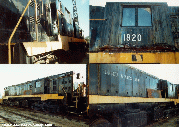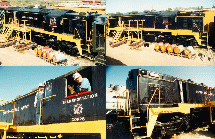Locomotive 1820
 U.S. Army Transportation Corps #1820 as shown in the final stages of restoration at the
Campo, CA shops of the San Diego Railroad Museum. When the work on its EMD 567B-16 Diesel
is completed she will work on the museum's excursion trains, as #1809 does now. The 567
engine is a V-16 2-stroke with 567 cubic inches for each of its cylinders, and holds 200
gallons of lube oil and cooling water. It produces 1600 HP @ 850 RPM. This is small by
today's standards.
U.S. Army Transportation Corps #1820 as shown in the final stages of restoration at the
Campo, CA shops of the San Diego Railroad Museum. When the work on its EMD 567B-16 Diesel
is completed she will work on the museum's excursion trains, as #1809 does now. The 567
engine is a V-16 2-stroke with 567 cubic inches for each of its cylinders, and holds 200
gallons of lube oil and cooling water. It produces 1600 HP @ 850 RPM. This is small by
today's standards.
Picture date: November 26, 1994
Photo by Randy Houk
Brief service roster
Delivered by EMD in june 1952
Immediate transfer to Belt Railway of Chicago in 1952
Transfer to Canadian National Railway for cold weather testing.
Transfer back to BRC in may 1953
Transfer to Ft. Eustis in june 1953
17 years of active duty at the fort's Military Railroad
Transfer to National Transportation Group, Rail Service Division's storage site (Hill Air
Force Base, Utah) in 1971
Donated to Pacific Southwest Railroad Museum in 1982
Restoration started in 1992
Still active at the San Diego RR Museum in Campo, CA.
A cold job to start with
On acceptance of the military, most of the units were shipped to the Transportation
Corps storage facility at Marietta, Pennsylvania. Unit 1820 was an exception as it was
destined to be used in cold weather testing later in the year. The Belt Railway of Chicago
(BRC), an interchange railroad on the west side of Chicago near La Grange performed the
break-in over several months, by using th diesel in its transfer service operation. By
november 1952, No 1820 and 1809 (at Marietta) both had their assignments for duty in
Arctic climes. No. 1820 was shipped to the Canadian National Railway (CN) at Winnipeg for
cold weather testing on their railroad. CN sent the locomotive north to the Pas Division
on its Hudson Bay Railway (HB). There it went into operation on the main line between the
Pas and Churchill (railhead on Hudson Bay). CN was still using steam engines on the line,
so the USArmy's No 1820 was the first diesel to serve there. The unit was used for all
types of service, including passenger, freight and work trains. In may 1953, the unit went
back to the BRC shops at Chicago. Here, the unit was torn down to determine if the cold
weather had caused any abnormal wear. On inspection, nothing was found.
A good job at Ft. Eustis
The unit was then shipped to Ft. Eustis and arrived there (probably) in june 1953. At
Ft. Eustis, No 1820 was assigned to the fort's Military Railroad and placed into regular
service after receiving a new paint scheme consisting of adding yellow handrails, belt
line, steps and the side steps skirt. No 1820 served in passenger, freight and work trains
on the railroad for 17 years.
 OCS candidates at Ft. Eustis, VA, as they progress through
the different phases of training. (US Army photograph, 23 september 1966)
OCS candidates at Ft. Eustis, VA, as they progress through
the different phases of training. (US Army photograph, 23 september 1966)
In 1962 or 1963, the unit had its first and only major accident. It was switching a
train of eight or nine loaded coal cars to a heating plant spur. The diesel was cut off
the train at a siding so it could run around the train and push the cars into the spur. In
the process it lost its air on a down grade and, without brakes, rammed into the
stationary cars. No one was killed and the diesel was repaired in the railroad's own shop.
It returned to service, albeit with a slight twist in the frame at the short hood end, and
continued to operate at Ft. Eustis for many more years.
A sad story...
About 1970, the Transportation Corps deactivated the military railway operating unit at
Ft. Eustis, and also shut down its railroad training program there. The industrial portion
continued to operate with civilian employees. Most of the rolling stock, including the
1820, was declared surplus to the Fort's needs. In 1971, the unit was shipped to the
National Transportation Group, Rail Service Division's storage site at Hill Air Force
Base, Utah. It was only a matter of time before #1820 was to give up some of its
components to keep the other MRS-1's in operation. By the summer of 1981, the military had
decided to declare the locomotive excess to government needs, along with Air Force unit
no. 1809.
With a happy end!
Finally, both 1820 and 1809 were donated to the Pacific Southwest Railroad Museum
(PSRM) and shipped to San Diego in early 1982. At the museum, No 1809 was the one that was
restored and placed in operation on the museum's demonstration railroad in 1986. No. 1820
continued to be a source for parts even after No 1809 was in service. By 1992, the 1820
was finally only a rusted hulk and an eyesore on the property. A group of museum members,
on their own, decided to save the unit from further deterioration and restore it as much
as possible. Today, it is running again, together with unit 1809 at the San Diego RR
Museum and the SD&R Railway, subdivision of the PSRM.
Restauration project of the EMD MRS-1 #1820
What follows, is a partial mirror (taken at november 16, 1995) from the San Diego Railroad Museum Diesel Gallery
at the San Diego Railroad Museum (SDRM) where two of
these locomotives are restored. Only the small size pictures are available at my site. If
you are in the USA, it is probably faster to use the original site.
Locomotive 1820 (before)
 These four views show MRS-1 #1820, last in a series of 13
Military Road Switchers built by the Electromotive Division of General Motors for the
United States military during 1951 and '52. These photos date back to February of 1992,
when Dave Slater, longtime member (engineer/ fireman/brakeman/conductor) of the San Diego
Railroad Museum was putting together a plan and crew to get #1820 running again.
These four views show MRS-1 #1820, last in a series of 13
Military Road Switchers built by the Electromotive Division of General Motors for the
United States military during 1951 and '52. These photos date back to February of 1992,
when Dave Slater, longtime member (engineer/ fireman/brakeman/conductor) of the San Diego
Railroad Museum was putting together a plan and crew to get #1820 running again.
This 6-axle locomotive uses a 16-567B two-stroke Diesel engine of 1600 HP, and last
operated more than 15 years ago, including sub-arctic testing in northern Canada. It has
variable gauge trucks, so that it could be run on standard 56 1/2" gauge tracks and
three larger gauges such as is found in Siberia and North Korea. Locomotive #1809, third
in the series from EMD, operates every weekend at Campo, CA. pulling our demonstration
train over 1.4% grades in eastern San Diego County.
Locomotive 1820 (after)
 These photos show the progress that's been made on
Locomotive 1820 since February of 1992 when the restoration project began. Project leader
Dave Slater has orchestrated the many aspects of the cosmetic and mechanical facelift of
this locomotive. Dave can be seen waving from the fireman's side cab window, with Leonard
Lovett, ex-Southern Pacific fireman standing to the left.
These photos show the progress that's been made on
Locomotive 1820 since February of 1992 when the restoration project began. Project leader
Dave Slater has orchestrated the many aspects of the cosmetic and mechanical facelift of
this locomotive. Dave can be seen waving from the fireman's side cab window, with Leonard
Lovett, ex-Southern Pacific fireman standing to the left.
Note the new black and yellow paint job, as delivered from the EMD factory in La
Grange, Ill. in 1952. Note also the area between the word "CORPS" and the
insignia. This cab-width strip was rotted out badly, as the "before" collage
showed. Other body parts have also been cleaned out and welded like new by Dick McIntyre,
the museum's "metal magician." He also created the two exhaust stack covers, as
can be seen in the upper photos. The two upper photos also show five 55 gallon drums,
which will be used to hold the 200 gallons of engine lube oil which will soon be drained.
The crankcase will then be inspected and cleaned before the same oil is put back in.
Two cylinder heads are now in the machine shop, waiting for the exhaust valves and
seats to be ground and re-installed. The heads were removed because the water seals leaked
during a test fill. After these heads are back on the engine it will be started, turned
over by two new "unit" batteries supplying 64 volts to the generator/starter.
After the brake valves have been sent out for rebuilding, #1820 will move under its own
power after more than 15 years.
All funding for this project has come from donations from those interested in seeing
#1820 run again. All of us working on #1820 are volunteers. The current schedule calls for
the "coming out event" to happen this fall, with representatives from the United
States military and the public invited to attend.
If you have ever operated one of these locomotives while serving in the U.S. military,
please let us know, and we'll pass on your information to Dave Slater.
Here, you can read some more about the finalisation on the
restauration of unit 1820 (copy from SDRM).
 U.S. Army Transportation Corps #1820 as shown in the final stages of restoration at the
Campo, CA shops of the San Diego Railroad Museum. When the work on its EMD 567B-16 Diesel
is completed she will work on the museum's excursion trains, as #1809 does now. The 567
engine is a V-16 2-stroke with 567 cubic inches for each of its cylinders, and holds 200
gallons of lube oil and cooling water. It produces 1600 HP @ 850 RPM. This is small by
today's standards.
U.S. Army Transportation Corps #1820 as shown in the final stages of restoration at the
Campo, CA shops of the San Diego Railroad Museum. When the work on its EMD 567B-16 Diesel
is completed she will work on the museum's excursion trains, as #1809 does now. The 567
engine is a V-16 2-stroke with 567 cubic inches for each of its cylinders, and holds 200
gallons of lube oil and cooling water. It produces 1600 HP @ 850 RPM. This is small by
today's standards. 

